From the Ground Up: Giovanni Aloi and Andrew S. Yang in Conversation about Earthly Observatory
Andrew Yang:
The planning for this exhibition and much of the selection of works took place prior to the COVID-19 pandemic, the new reports about the alarming extent of global warming, the racial justice protests, and other major events besides.
In that context, if we were to conceive of this exhibition afresh now, do you think it would be very different?
Giovanni Aloi:
I don’t think it would be drastically different. In more ways than one, the pandemic has evidenced what we already knew existed. The sense of urgency has changed, for sure. If anything, throughout the pandemic, I became concerned that the world was getting distracted from the all-encompassing issues of climate change. I mean, of course we had to attend to the imminent threat. But it was interesting to see how quickly climate change disappeared from the headlines to make room for the pandemic and social justice news. I think the works in Earthly Observatory offer a “healthier” balance in which these themes are shown as interdependent rather than hierarchized in accordance with cultural priorities. So, despite the temporary shift in discourses and concerns, I think the exhibition remains timely and well-balanced.
What concerns mapped by the works in the exhibition are more urgent in your opinion and why?
AY:
Urgency suggests something immediate, but also short-lived. However, I think many of the concerns raised in the exhibition are ones that some might describe as part of “the long now.” That is partially why they are such a challenge to address, it is almost a kind of intergenerational urgency. Meredith Leich’s Animated Drawings for a Glacier (2018-2021) raises this duality by visually collapsing the timescales of ice ages with that of human-induced global warming and sea level rise. Human temporality has folded itself into geological temporality by force. With global warming, the world—and the Global North especially—has the next twelve years to change how the world powers itself, in order to avoid a future climate that is far less livable for humans and a myriad of other species. Again, that urgency is not even as much about ourselves in this lifetime as much for the many generations to come. In the exhibition, the Doomsday Clock represents climate risk as well as nuclear risk in a foreboding fashion, but I don’t see all of these urgencies in the show all as gloom and doom. Terry Evans’s portraits of activists fighting against the relocation of a heavily polluting metal shredding plant to a Black and Latinx-majority neighborhood, Hunger Strikers for Southeast Side (2021), shows how communities can rally quickly to confront environmental injustices. Meanwhile, Anaïs Tondeur’s Chernobyl Herbarium (2011–ongoing), Peggy Macnamara’s Coelacanth (2010), a portrait of a fish that has survived mass extinctions, and Norman W. Long’s Big Marsh Soundscape (Penthouse Mix) (2019) all express a tenacity, a resilience, and even a kind of hope, in terms of life’s ability to adapt and persist in the face of massive change.
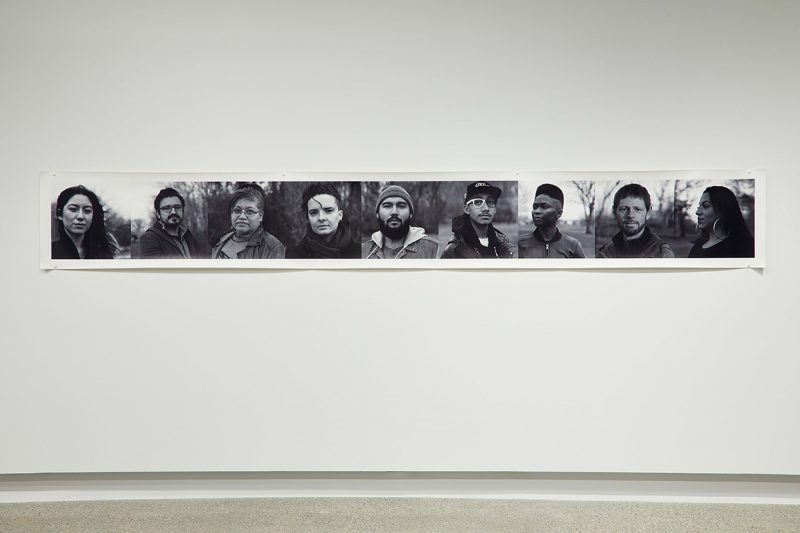
Terry Evans, Hunger Strikers for Southeast Side (2021)
GA:
I remember that at some point during the curatorial process you became particularly concerned with grids. Did your science background play a role in that?
AY:
There was a moment when I felt like we had a preponderance of works whose default display was a grid. As you know, I suggested to a number of artists alternative configurations for their work in this exhibition. With my background in the sciences, I might be especially sensitive to grids, pros and cons. They can provide a crucial visual order to observation—enhancing visibility, measurement, comparison, and keeping-track. Given that, it makes sense that grids are a feature of an exhibition concerned with observation. For example, the grid of photographs documenting the many discovered creatures in Mark’s Dion’s Roundup: An Entomological Endeavor for the Smart Museum of Art, (2000/2006) references field biology’s methods and visual conventions.
Many grids, however, have little to do with science per se, but with our tendency to order and organize more generally. This raises the broader question of how rectilinearity relates to the remarkable curvaceousness of the Earth and the organic, and how geometry is employed to assert control of the earthly. Living in Chicago, we literally inhabit a grid—the city’s whole structure is premised on rationalizing space for the purposes of property, commerce, and civic management. Some of these concerns find a place in the exhibition: the towers of layered wood planks in Tim Lamey’s photograph Stacks of Lumber at Sawmill (2017) are volumized grids that rise up like skyscrapers, while his other photograph, Log Yard at Papermill (2014) offers a contrasting rolling landscape made out of round, unmilled logs. That is also why the fantastically reticulate cast of an ant nest in the exhibition by Walter Tschinkel was of interest to me for this exhibition—not only as the expression of negative space or an invisible structure made visible, but as a nonlinear architecture constructed by other social organisms in contrast to our human-built environments.
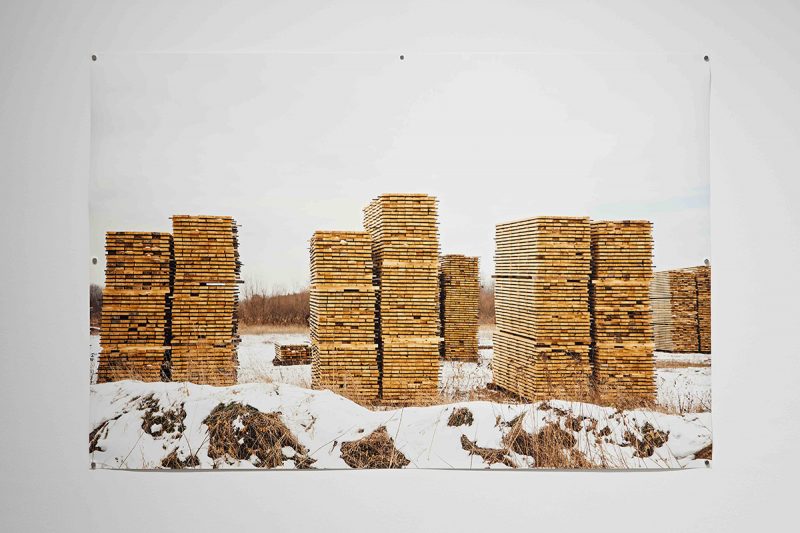
Tim Lamey,Stacks of Lumber at Sawmill (2017)
All that said, in the end we can’t get rid of the grid. Most of the prints, drawings, paintings, and projections throughout this exhibition abide by the same boxy conventions that interior architecture of the galleries themselves follow. Rena Detrixhe’s Red Dirt Rug (2021) contains an elaborate filigree packed within a rectangle, itself framed by the rectangular room, while Erin Wiersma’s energetic char drawings buzz within the confines of archival squares. While those conventions can be oppressive, they also serve key visual purposes for enhancing attention and shape. Hundertwasser claimed that paradise was destroyed by the straight line, but as a framing device, the grid will remain a crucial frenemy of nonlinear form.
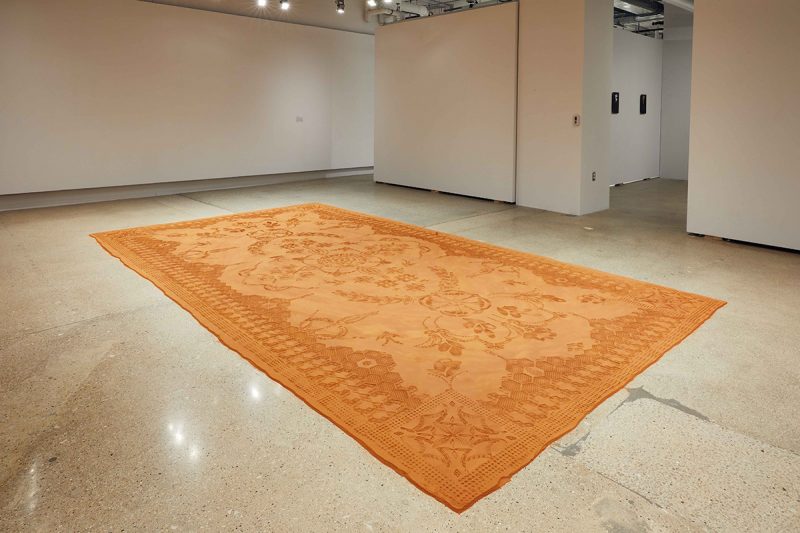
Rena Detrixhe, Red Dirt Rug (2021)
I am curious about whether curating this exhibition raised any new questions, or changed your perspective, on issues of art and the environment.
GA:
Curating this exhibition has brought me to more carefully consider aspects of human-non-human interactions beyond my research focus on materiality and representation. I personally enjoyed thinking more thoroughly, and through the works of art we have selected, about different conceptions of “land.” I think this is a particularly important subject right now. From my perspective as an immigrant to the United States, rethinking my understanding of the land has been an important part of my process of cultural assimilation. In Europe, we think about the land in very different ways. There, the indigenous people are a white majority who currently feel threatened by a minority of mostly non-white immigrants. Europe has also been pretty efficient at erasing colonialism and its persistent legacies. What I learned in school there was certainly whitewashed—purged of all the cruelty and narrated as a fable of progress and civilization. I think the focus we have given to the concept of land in the central gallery sets the tone for the rest of the exhibition in the sense that it upturns all certainties, unsettling the earth under our feet. It is politically and culturally destabilizing.
Another important formative aspect related to the curatorial process was the focus on narratives and storytelling. In one way or another, each work tampers with institutional or historical narratives to make us rethink our certainty and see everything we thought we knew afresh, from different perspectives.
Speaking of history as context and narrative, this makes me think of an often cited passage in Cultural Criticism and Society (1949) by Theodor Adorno: “To write poetry after Auschwitz is barbaric.” With these words, the philosopher tried to express his dismay at humanity following the atrocities of World War II. While wanting to avoid false equivalences, I often wonder about sublime strategies and other approaches that might be read as insensitive or glamorizing in the context of the Anthropocene. I guess I am asking a question about the aesthetics of the Anthropocene and “what is appropriate”?
AY:
I think this gets to the tension within “observation,” which suggests a sense of inquiry, neutrality, and maybe objectivity. If the exhibition is itself an “observatory,” then what are the implications for its intentions to move or provoke, rather than just describe and depict? With global warming, deadly pandemics, and more, it is clear that “the facts” are not enough to motivate people to think, to care, or to act in new ways. Something also needs to draw you into looking long enough so that you can be taken by surprise, and consider something you had no intention to otherwise. I think forms of beauty or maybe the sublime can play a pivotal role in that. The Great Silence (2014) by Allora & Calzadilla (in collaboration with Ted Chiang) is a remarkable work that weaves science fact and science fiction together in a way that generates empathetic speculation and reflection. It is beautiful, poetic, and ironic in describing the diversity of creatures we are driving to extinction here on Earth, all the while desperately looking for life in the cold and deep reaches of outer space. I see pieces like The Great Silence as trying to re-sensitize viewers to contradictions we habitually screen off. Observing and expressing the contradictory is also something I admire in Kelly Church’s basket Sustaining Traditions—Then and Now (2020), which is woven in a shape akin to both a Fabergé egg as well as an emerald ash borer beetle, the very invasive species that is decimating the black ash trees upon which her indigenous basket-weaving practice relies. The idea of how traditions are sustained in the face of global change, then and now, is directly and materially manifest in the work.
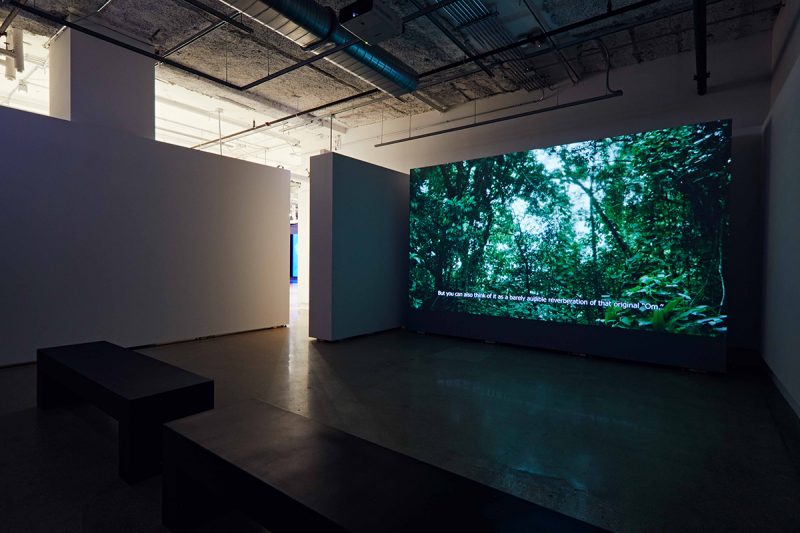
Allora & Calzadilla (in collaboration with Ted Chiang), The Great Silence (2014)
One thing that I feel like your question might be suggesting is that the Anthropocene and global warming are both unmitigated catastrophes. However, the IPCC (Intergovernmental Panel on Climate Change) reports and research in other fields tell us that we can in fact mitigate those catastrophes—that it will take the most extraordinary effort, but that we are not (necessarily) at the End. I think it is important to consider perspectives of those like First Nations scholar Leanne Betasamosake Simpson who has observed that, “It’s been the end of the world for somebody all along.” 1 Ojibwe artist Andrea Carlson puts the same point another way: “We’ve generated many speculative ends for humanity. Unfortunately for many Indigenous people, our past and continuing genocides are ever present.” 2 We live day-in and day-out coping, fighting, and also ignoring, barbarism the world over, often perpetrated in our name. Our tragedies should not be in competition; for better or for worse, none of them yet are likely the End. Instead, we have many ongoing crises to acknowledge, act upon, and adapt to. In that framing, maybe the question of what is or isn’t appropriate becomes secondary to asking about the roles that beauty, contradiction, humor, and spectacle all need to meaningfully play now.
Your last question raised the issue of “the Anthropocene.” Some argue that the Anthropocene makes it clear that collectivity—whether in the arts, sciences, or cultural creation otherwise—needs to be more of the rule rather than the exception if we (whoever that “we” might be) are going to address all of the challenges being faced. What do you think of this claim?
GA:
Yes, at least to a certain extent. So much of what is dysfunctional about our current cultural state of affairs derives from the compartmentalization of disciplines that unfolded during the Enlightenment. I don’t think this was necessarily a mistake. The emergence of history, science, art history, and so on required a narrow specialization in order to clearly define themselves but I think we are now ready to shake things up. Collaborative approaches are the only way to move forward in order to avoid the blinkeredness that has characterized the past. As you know, the humanities are just “discovering” biological interconnectedness of the kind science has been well aware of for over a hundred years. How is it possible that so much Western philosophy has ignored, or made false statements about, animals, plants, and ecosystems while the scientific knowledge was there all along?
Staying with the question of disciplinarity and lack of communication among disciplines: is Earthly Observatory an “art and science” exhibition?
AY:
There are a number of works by artists and non-artists alike, but I don’t see this exhibition as highlighting specific connections, or distinctions, between art and science as fields. I think the works that originate “outside” of art come naturally to a project that presumes to take on a planetary scope. Many of the artists themselves engage scientific topics or rely on its methods—the microbial cultures of Ken Rinaldo’s Borderless Bacteria/Colonialist Cash (2021), the rayograms of Anaïs Tondeur, the infrared video of Terike Haapoja, and the speculations of Allora & Calzadilla + Chiang. In that regard, including works of scientists or their institutions felt completely consonant to me. I think Documenta 13 and the Istanbul Biennial in 2015 (both curated by Carolyn Christov-Bakargiev) are compelling examples of engaging myriad disciplines that elude an easy reduction to “art and science.” Like you, I hope that we are moving beyond some of this compartmentalization—I worry it does as much to keep the fields apart as bring them together. Maybe Earthly Observatory can play some small part in offering a different vision, one that is meta-disciplinary?
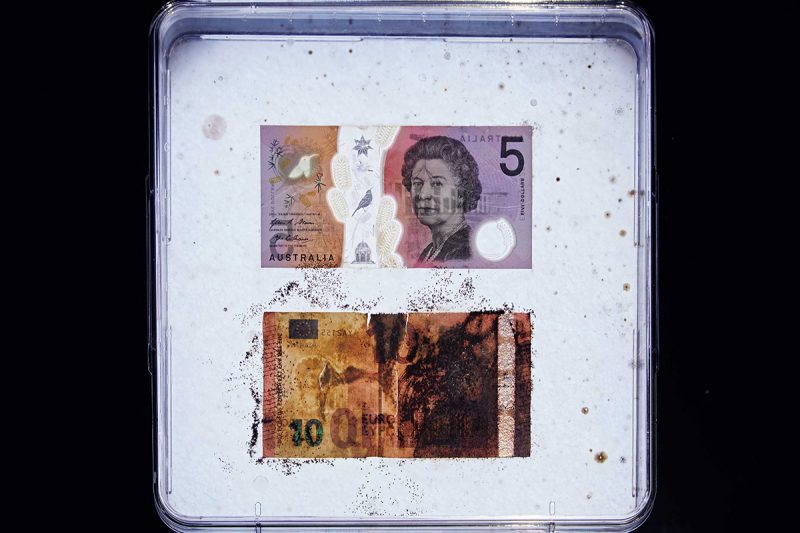
Ken Rinaldo, Borderless Bacteria/Colonialist Cash (2021)
While you and I come from different academic backgrounds, this exhibition brought artists and artworks to each other’s attention that we otherwise were not aware of. In that process, are there any especially interesting relationships between artworks that have emerged for you?
GA:
The works we have selected for the Seeing, Marking, and Tracing gallery outline a relationship between land and body that was particularly interesting and to a certain degree novel to me. I think that’s what effective curation can do: extend and bridge works of art, generate allusions, highlight parallels, and narrate through juxtaposition. As a practice, curation inserts itself between the seeing andsaying relationship already articulated by the artist in order to tell a bigger story.
For instance, Nandipha Mntambo’s modelled cowhide further problematizes many of the themes explored in the Conditions of Representation gallery. Buhlungu besikhala selu tsandvo (The unkind spaces of love) (2013), inscribes registers of domestication of cows and women by collapsing the material presence and absence of both through an indexical blurring of human and animal. Brought into dialogue with the works by Peggy Macnamara, Cole Swanson, Zoé Strecker, Ken Rinaldo, and Xavier Cortada, Mntambo’s piece also reinvents the specimen. It reconfigures the objectifying tradition of taxidermy and natural history to make struggle and objectification visible—these are part of representational registers that have been excluded from institutional discourses until recently. Crucially, the folds of the modelled skin also evokes the land—a geography of social injustice that is perpetrated by capitalism and patriarchy over time to the point that it naturalizes itself in the materiality of the living. The woven baskets by Kelly Church and Cherish Parrish can be seen in conversation with the Mntambo piece and the question of abstraction/figuration in representation. I see these baskets in dialogue with Ursula K. LeGuin’s “theory of the carrier bag” as the first tool of civilization. In this case, like in Mntambo’s piece, Parrish imbeds the human form into the vegetal material to re-negotiate the boundaries separating nature and culture and establish new continuities between us and ecosystems to evidence interdependency.
AY:
What might be different about Earthly Observatory in the context of other exhibitions exploring kindred themes—on the Anthropocene specifically, or eco-cultural concerns more broadly?
GA:
Based on my knowledge of other exhibitions addressing the Anthropocene, Earthly Observatory strikes a good balance between fact and fiction to provide more than a simple wake up call or an illustration of how artists can envision better futures (that often unfortunately remain impossible to actuate). I think the notion of observation is what makes this exhibition substantially different from previous ones. The idea of observing is central to the notion of accessibility and the politics of the gaze. This subject, as you know, has gained relevance in the context of recent thinking addressing the history of natural history and its intersections with colonialist practices. I enjoyed the idea of transposing this type of inquiry to the contemporary sphere so as to more thoroughly excavate the legacy of this epistemic modality and how it defines our conceptions of the world today. In this context, I think that the notion of “observation” has enabled us to contextualize urgent ecological issues like climate change within a more complex frame of references. Who is allowed to look? What do they see? Who and what remains unseen and why? What chains of inference are triggered as a result? How is social justice linked to visibility and invisibility and how can art help us correct histories of erasure?
In this exhibition, every artistic medium is not only a material manifestation of the non-human in the gallery space, but a metaphorical incarnation of a “thinking modality.” I say this in the context of Michel Foucault’s idea that knowledge is shaped by the power of the institutional and cultural gaze as much as it is defined by the actual medium through which observation can take place. Every medium deployed by each artist reveals something while concealing something else. In this sense, Earthly Observatory is much more than an exhibition on climate change and the Anthropocene—it poses more radical questions about the essence of reality and our limited perceptual abilities to access the workings of life on this planet, thus reminding us to remain humble.
As an exhibition, it presents a more nuanced picture, one in which scientific optics are critically appraised, but also combined with other epistemic modalities and disciplines. Indigenous knowledge and non-institutional perspectives are presented in the context of the exhibition with the same degree of respect. I think the exhibition invites viewers to negotiate different ways of knowing in order to craft their own personal perspectives.
References:
1 “Dancing the World into Being: A Conversation with Idle No More’s Leanne Simpson.” By Naomi Klein Yes! March 6, 2013.
2 “The Mississippi is the Opposite of the Anthropocene.” By Andrea Carlson. Andrea Carlson Blog. February 18, 2020.
https://www.mikinaak.com/blog/the-mississippi-is-the-opposite-of-the-anthropocene